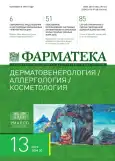Experience with the use of botulinum toxin type A in combination with a PDL laser for the treatment of hypertrophic scars
- Authors: Verbovaya E.D.1
-
Affiliations:
- Central State Medical Academy of the Administrative Department of the President of the Russian Federation
- Issue: Vol 30, No 13 (2023)
- Pages: 56-58
- Section: Original articles
- Published: 04.12.2023
- URL: https://journals.eco-vector.com/2073-4034/article/view/625934
- DOI: https://doi.org/10.18565/pharmateca.2023.13.56-58
- ID: 625934
Cite item
Abstract
Background. Hypertrophic scars (HS) are a pressing problem in modern medicine and significantly affect the quality of life of patients. Currently, various treatment protocols to achieve the greatest effectiveness of HS therapy are being developed.
Objective. Evaluation of the effectiveness of the combined use of botulinum therapy with a PDL laser for the treatment of HS, taking into account clinical examination methods, which included a general examination and assessment of the condition of scars using the VSS (Vancouver scar scale).
Methods. 15 patients with HS were followed-up at outpatient settings. Among the patients there were 8 (54%) women and 7 (46%) men aged from 25 to 32 years, the duration of scar existence ranged from 6 months to 1 year. All patients underwent intralesional injection of botulinum toxin type A in combination with a pulsed dye laser (585 nm PDL). The VSS dermatological scale and the SBSES scar rating scale (Stony Brook) were used to evaluate the results.
Results. According to the data obtained, VSS indicators in the entire group ranged from 8 to 11 points, SBSES indicators from 1 to 3 points before treatment. After therapy, VSS scores decreased to 4–7 points, SBES scores increased to 2–4 points. There was a decrease in the severity of subjective symptoms after treatment: in 10 patients from the presented group, itching and burning disappeared completely, 5 patients noted a decrease in the frequency and intensity of these symptoms.
Conclusion. The combination of intralesional injection of botulinum toxin type A and pulsed dye laser therapy with a wavelength of 585 nm was effective, and the result depended on the duration of treatment and the timing of the start of therapy. It should be noted that there was an improvement not only in the appearance of the scars, but also a decrease in subjective symptoms, which significantly improved the quality of life of patients.
Keywords
Full Text
About the authors
E. D. Verbovaya
Central State Medical Academy of the Administrative Department of the President of the Russian Federation
Author for correspondence.
Email: verbovaya.lena@gmail.com
ORCID iD: 0000-0002-1446-4450
Dermatovenerologist, Teaching Assistant at the Department of Dermatovenereology and Cosmetology
Russian Federation, MoscowReferences
- Круглова Л.С., Течиева С.Г., Стенько А.Г., Шматова А.А. Современный взгляд на инновационные методы терапии патологических рубцовых деформаций. Клиническая дерматология и венерология. 2014;12(5):105–116 [Kruglova L.S., Techieva S.G., Stenko A.G., Shmatova A.A. A modern view on innovative methods of treating pathological scar deformities. Klinicheskaya dermatologiya i venerologiya. 2014;12(5):105–116. (In Russ.)].
- Мантурова Н.Е., Круглова Л.С., Стенько А.Г., Рубцы кожи. М., 2021. [Manturova N.E., Kruglova L.S., Stenko A.G., Skin scars. M., 2021. (In Russ.)].
- Ho Jun Lee, Yong Ju Lang Recent Understandings of Biology, Prophylaxis and Treatment Strategies for Hypertrophic Scars and Keloids 2018. Doi.org/10.3390/ijms19030711.
- Leszczynski R., da Silva C.A.P., Pereira Nunes Pinto A.C. et al. Laser therapy for treating hypertrophic and keloid scars. Cochrane Database Syst Rev. 2022;9(9):CD0116422022. doi: 10.1002/14651858.CD011642.
- Arno A.I., Gauglitz G.G., Barret J.P., et al. Up-to-date approach to manage keloids and hypertrophic scars: A useful guide. 2014. doi: 10.1016/j.burns.2014.02.011.
- Minglei Bi, Pengfei Sun, Danyi Li, et al. Intralesional Injection of Botulinum Toxin Type A Compared with Intralesional Injection of Corticosteroid for the Treatment of Hypertrophic Scar and Keloid: A Systematic Review and Meta-Analysis. 2019. doi: 10.12659/MSM.916305.
- Hamed Memariani, Mojtaba Memariani1, Hamideh Moravvej, Mohammad Shahidi-Dadras. Emerging and Novel Therapies for Keloids: A compendious review. 2021. doi: 10.18295/squmj.2021.21.01.004.
Supplementary files





